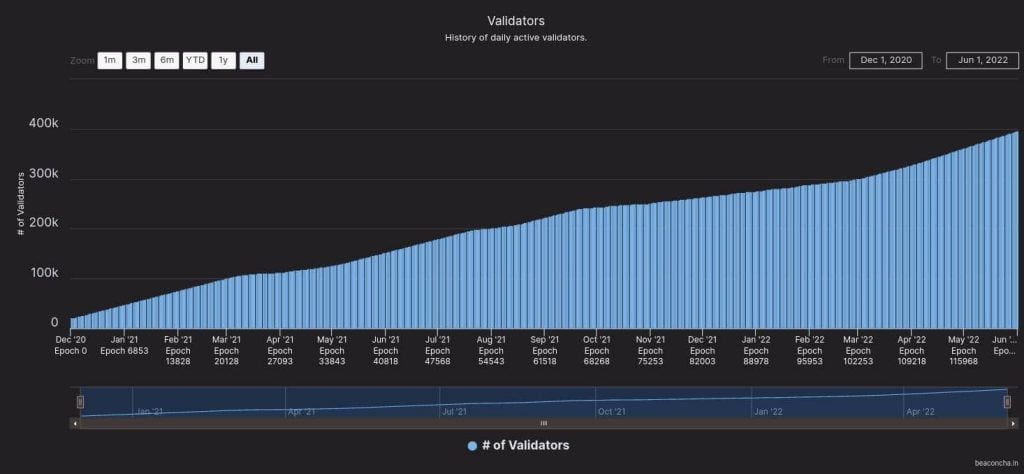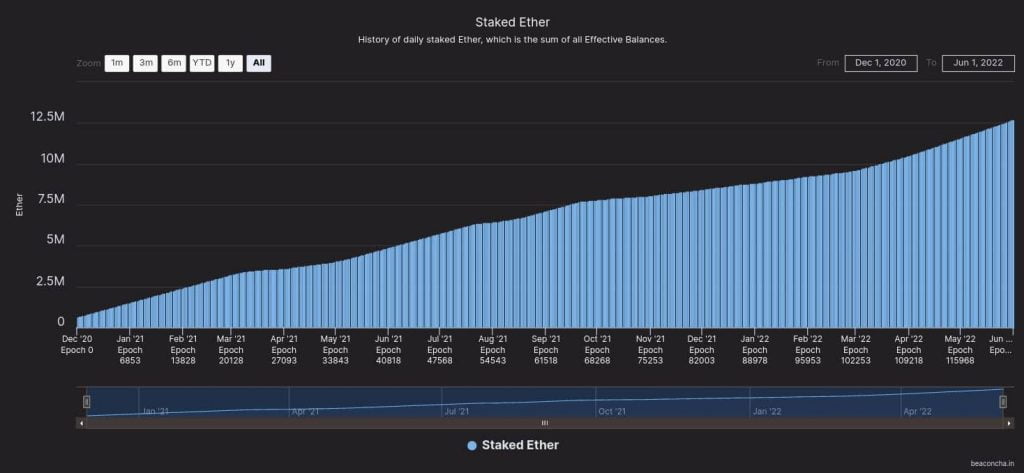Ethereum 2.0 strengthens its foundation before the main Ethereum network merges with this new version.
Ethereum 2.0 to launch with at least 400000 Validator Nodes In the coming days. They will verify transactions and ensure the correct functioning of the blockchain. At the time of writing, 396,500 validators deposited their ethers (ETH) into the Beacon Chain Smart Contract, the original shard of the new network, meaning that there are 3,540 to reach 400,000. Based on its current growth rate, Ethereum could hit this milestone in the next 2 to 3 days.
Ethereum 2.0 reaches this significant number 18 months after creating the contract to deposit ETH in staking, with which a user acquires the right to be a validator on the network. One hundred thousand validators were added in three months, considering that the network had reached 300,000 in February 2022.
You can access the statistics on the current status of the network on beaconcha.in It also notes that the ETH amount deposited is nearly 12,686,800. Participants should keep all contributions until the Merge is completed, as they’re locked in the Smart Contract until then.
Staking Pools
In addition, it is essential to note that the final number includes those deposited by independent nodes and those in staking pools. This way, they offer the possibility for many people to combine their resources to collaborate with the maintenance of Ethereum 2.0 and get rewards for doing so.


Ethereum will transition to a Proof of Stake (PoS) consensus algorithm instead of the more energy-intensive Proof of Work (PoW). According to the developers, this will occur after the Merge with the new blockchain, which users and traders expect in the second half of the year.
Graphic card rigs will not mine new coins when hashing transactions. Instead, designated validators will put their money up as collateral for approved transactions. If they do not act honestly, the system penalizes the validators, and they could lose their funds.
Why do you have to deposit ETH to become a validator?
Ethereum Foundation, which brings together the leading developers of the network, indicates in its blog that the role of the validator is essential—the network incentivizes validators to act honestly, not to lose their funds in staking.
The sum of 32 ETH was chosen arbitrarily by the Ethereum developers. With this amount, equivalent to $62,900, the formula determines the number of allowed validating nodes. This procedure, in turn, preserves the efficiency of the network by reducing the amount of information transmitted between them.


Proof-of-stake networks move toward The Merge
While the number of validators is still growing, Ethereum 2.0 developers “do their homework” and continue to test all stages and circumstances of the Merge on test networks.
Without going any further, developers have already launched Ethereum 2.0 on the Ropsten testnet. Days earlier, this same testnet suffered an involuntary halt caused by an excessive hash rate.
Despite all this progress, the developers postponed the difficulty bomb on the Ethereum mainnet for at least two months. This stage of the process will be the one that will put a definitive end to mining. This scenario is getting closer and closer, which has the miners of this network looking for alternatives between selling their equipment or migrating to another cryptocurrency.
